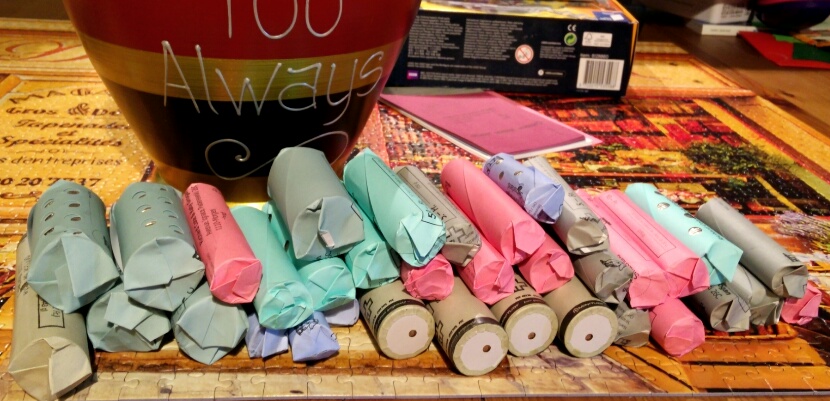
You must be logged in to be able to see this content.

The beaver is a proud and noble animal
Notes from a bemused canuck


Media error: Format(s) not supported or source(s) not found
Download File: https://www.flubu.com/blog/wp-content/uploads/2017/01/Roger_Waters-Pigs.mp4?_=1We went to the Centre Nordique Saint-George, in the Jura Vaudois. Something that we will do again!

This is what one year of always emptying your pockets every night looks like.
Ingredients for each noodle cup
1 to 3 teaspoons flavor base — soup stock paste, miso paste, curry paste
1 to 3 teaspoons flavoring extras, optional — chili-garlic sauce, soy sauce or tamari, coconut milk, sesame oil, Sriracha or other hot sauce
1/4 to 1/2 cup filler ingredients — frozen corn, frozen carrots, frozen peas, diced tofu, leftover cooked meat, dried or thinly sliced mushrooms, thinly sliced spinach or other hearty greens, kimchi, soft-boiled or hard-boiled egg
3/4 to 1 cup noodles — cooked udon, cooked yakisoba or ramen, cooked soba noodles, cooked spaghetti or fettuccine, cooked rice noodles
1/4 to 1/2 cup fresh ingredients — fresh herbs, sliced green onions, bean sprouts, sliced lime or lemon
Assembling the Noodle Cups
When packing up your soup components, add everything in layers — not only does this keep dry and wet ingredients separate until you’re ready to mix, but it looks pretty and makes an easier assembly line.
Place flavor base and flavor extras in the bottom of the cup: If it’s a paste, like soup stock or miso paste, spread it around a little so it dissolves more easily once you add the hot water. Also add any flavoring extras.
Top with filler ingredients: Scatter your filler ingredients over the top of the paste. It’s OK if they get mixed in with the flavor base and extras.
Add the noodles: Pack the noodles down so they’re fairly compact. It’s fine if they stick together — they will un-stick once you add the water.
Finish with the fresh ingredients: If you’d like to keep these from getting mixed into the hot soup, pack these into a baggie that can be removed just before you add the water.
Seal and refrigerate: Place the lid on the container and refrigerate for up to a week. Use a dry-erase marker or masking tape label to write the contents of each jar so you can easily grab whichever combo of ingredients you want that day. (It’s best to keep the jars refrigerated until you’re ready to eat, but it’s OK to stash them in your bag for up to two hours.)
Cooking the Noodle Cups
Top with hot water: When you’re ready to eat, unscrew the lid and pour enough boiling water over the top of the noodles to cover.
Cover and steep: Place the lid back over the container. Let the soup steep for 2 to 3 minutes. The ingredients should be warmed through, but the soup is still nicely hot.
Stir thoroughly: Reach your chopsticks or fork deep into the cup and stir everything around thoroughly to mix the flavor base into the water and mix the filler ingredients into the noodles.
Eat right away! If you kept your fresh ingredients separate in a bag, scatter them over the top of the soup before eating.
Ingredients
10 large eggs
1 cup whole milk
1 teaspoon kosher salt
6 slices bacon, could also use ham
6 slices cheese, like cheddar or Swiss
6 English muffins
Instructions
Make the eggs: Whisk the eggs together with the milk and salt in a large mixing bowl. Film a 9×13 baking pan with cooking spray, and pour the eggs into the pan. Bake at 375F/190C until the eggs are puffed around the edges with golden spots, and a paring knife inserted in the middle comes out clean, 25 to 30 minutes. Cool completely.
Make the bacon (optional, while eggs are baking): Line a baking sheet with foil. Lay the bacon on the baking sheet in a single layer with no pieces overlapping. Turn up the edges of the foil to catch the grease. Place the bacon on the upper rack in the oven and bake until the bacon is crispy, 15 to 20 minutes. When finished, transfer the bacon to a plate lined with paper towels to drain. When cool, break each piece in half to make them easier to fit on the sandwiches.
Toast the English muffins: When the eggs and the bacon are both finished, place the English muffins cut-side-up on a baking sheet and toast in the oven for just a few minutes, until the edges are toasted. If desired, you can brush the muffins with butter before toasting.
Cut out the egg rounds: Use a spatula to lift the eggs out of the pan and onto a cutting board. Using a large biscuit cutter or drinking glass (roughly the same size as your English muffins), cut 6 rounds out of the eggs. (The scraps can be used to make more sandwiches if you have extra English muffins, or they can go in salads, stir-fries, or other quick meals during the week.)
Assemble the sandwiches: Lay the bottom halves of the English muffins in a row on your counter. Top each one with an egg round, a slice of cheese, and 2 pieces of bacon (if using). Finish by adding the muffin tops.
Wrap the sandwiches for freezing: Wrap each sandwich in a square of aluminum foil. Use a permanent marker to write the contents and date on the sandwich. Put all the sandwiches in a freezer bag or container.
Freeze for up to 1 month.
Reheating instructions: Unwrap the frozen sandwich and place on a microwave-safe plate lined with a paper towel. (The towel helps absorb some of the melting ice so the bread doesn’t get soggy.) Heat at full power for 1 to 1 1/2 minutes, or until the cheese is melted and the egg is warmed through.
Be creative. You can add chives to the egg mix or wilted spinach. Add hot sauce, or grilled mushrooms, or whatever else you want.